Click on images to enlarge
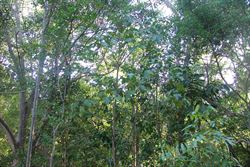
saplings growing in riparian vegetation along Enoggera Creek in Brisbane (Photo: Sheldon Navie)

habit (Photo: Forest and Kim Starr, USGS)

habit (Photo: Sheldon Navie)
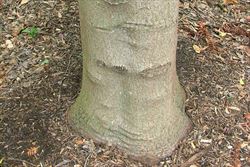
base of main trunk (Photo: Sheldon Navie)
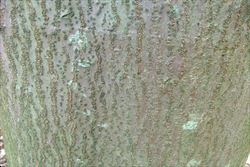
close-up of bark on main trunk (Photo: Sheldon Navie)
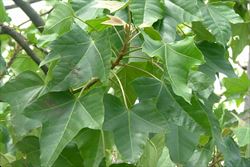
five-lobed leaves (Photo: Sheldon Navie)
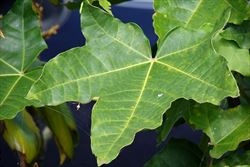
close-up of five-lobed leaf (Photo: Forest and Kim Starr, USGS)
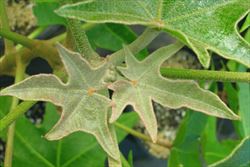
close-up of young leaves and new growth covered in tiny, greyish-brown, star-shaped hairs (Photo: Forest and Kim Starr, USGS)
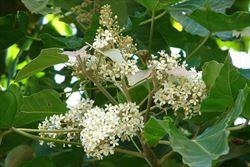
large, branched, flower clusters (Photo: Forest and Kim Starr, USGS)
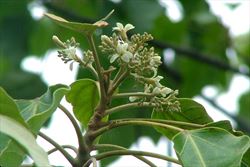
female flowers (Photo: Sheldon Navie)
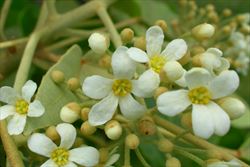
close-up of male flowers with yellow stamens (Photo: Forest and Kim Starr, USGS)
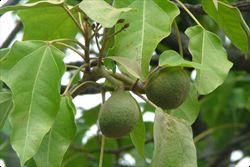
un-lobed leaves and immature fruit (Photo: Sheldon Navie)
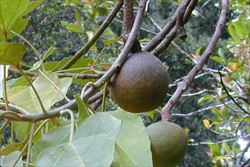
mature fruit (Photo: Forest and Kim Starr, USGS)
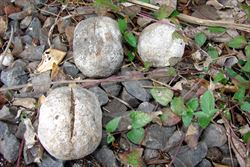
old fruit on the ground (Photo: Forest and Kim Starr, USGS)
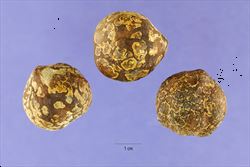
close-up of seeds (Photo: Steve Hurst at USDA PLANTS Database)
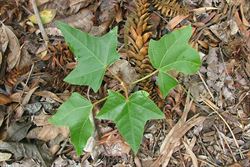
seedling (Photo: Sheldon Navie)
Scientific Name
Aleurites moluccanus (L.) Willd.
Synonyms
Aleurites moluccana (L.) Willd., orth
var.
Aleurites moluccana (L.) Willd. var. moluccana, orth
var.
Aleurites remyi Sherff
Aleurites triloba J.R.
Forst. & G. Forst.
Jatropha moluccana L.
Family
Euphorbiaceae
Common Names
candle nut, candle nut tree, candleberry, candlenut, candle-nut tree, candlenut tree, Indian walnut, kukui, kukui nut, kukui tree, lumbang, lumbang tree, lumbangtree, varnish tree, varnishtree
Origin
Native to the Indian sub-continent, south-eastern Asia and some parts of northern Queensland (i.e. the Cook and North Kennedy districts). However, because this species is widely cultivated and naturalised in the tropical regions of the world, its exact native range is somewhat obscure.
Naturalised Distribution
Sparingly naturalised in the Moreton district in south-eastern Queensland.
Also naturalised in the coastal districts of northern and central New South Wales and on Christmas Island.
Habitat
A potential weed of closed forests, forest margins, riparian vegetation, disturbed sites and waste areas.
Habit
A large tree usually growing 10-15 m tall, but occasionally reaching up to 30 m in height.
Distinguishing Features
- a large tree usually growing 10-15 m tall.
- the younger branches and leaf stalks are densely covered in silvery or greyish-brown
star-shaped hairs.
- its alternately arranged leaves (7-24 cm long and 4-20 cm wide) are
entire, three-lobed or five-lobed.
- its small whitish flowers are arranged in large branched clusters at
the tips of the stems.
- separate male and female flowers are present in these clusters, the
majority being female.
- its large rounded fruit (4-6 cm across) contain one or two large seeds.
Stems and Leaves
The bark on the main stem is relatively smooth and greyish-brown or dark grey in colour. The younger branches are densely covered in silvery or greyish-brown star-shaped (i.e. stellate) hairs.
The alternately arranged leaves are borne on stalks (i.e. petioles) 3.5-12 cm long, but tend to be crowded towards the ends of the branches. They are also covered in silvery or greyish-brown star-shaped (i.e. stellate) hairs when young, but become hairless (i.e. glabrescent) or almost hairless as they mature. These leaves (7-24 cm long and 4-20 cm wide) are egg-shaped in outline (i.e. ovate), elongated in shape (i.e. elliptic-lanceolate), or lobed (i.e. three-lobed or five-lobed). They have pointed tips (i.e. acute to acuminate apices) and entire, wavy (i.e. undulate to sinuate) or lobed margins. They also have two small raised structures (i.e. glands) where the leaf stalk meets the base of the leaf blade.
Flowers and Fruit
The greenish-white or whitish flowers are arranged in branched clusters (3-20 cm long and 10-14 cm wide) at the tips of the branches (i.e. in terminal panicles). Separate male and female flowers are present in these clusters, with most of the flowers being female (i.e. this species is monoecious). Both types of flowers have two or three sepals (2.5-3.5 mm long and 1.5-3 mm wide) and five white or cream coloured petals (4-8 mm long and 1.5-3 mm wide). The male flowers (about 5 mm across) are borne on stalks (i.e. pedicels) 5.5-10 mm long, have 15-26 yellow stamens, and are found near the tips of the flower clusters. The female flowers (8-10 mm across) are borne on shorter stalks (i.e. pedicels) 2-4.5 mm long and have an ovary topped with two short styles (0.5-2 mm long). Flowering occurs mainly during summer (i.e. from January to March).
The large fruit (4-6 cm across) are rounded in shape (i.e. sub-globose) or slightly two-lobed. They contain one or two large greyish seeds (23-32 mm long and 20-32 mm wide) that are broadly egg-shaped (i.e. ovoid). Fruit are present mostly during autumn and early winter (i.e. from April to June).
Reproduction and Dispersal
This species reproduces only by its large heavy seeds. These seeds are spread by gravity and possibly also by water. Plants are also spread through the deliberate cultivation of this species.
Legislation
This species is not currently declared under any state or local government legislation.
Management
As this species is not a declared plant, its control is not required and there are no restrictions on its sale or cultivation. However, it is an emerging environmental weed in south-eastern Queensland and should be controlled in sensitive bushland and conservation areas. It also should not be planted in revegetation areas or in amentiy plantings near environmentally sensitive areas.
Similar Species
Candle nut (Aleurites moluccanus) is very similar to another native species also known as candle nut (i.e. Aleurites rockinghamensis). However this species is only present in the wild in northern Queensland, and is relatiely rare in cultivation.
Younger plants are also similar to some of the native kurrajongs (Brachychiton spp.).
Notes
Candle nut (Aleurites moluccanus) is often planted as an ornamental, particularly in the coastal districts of eastern Australia. This species, which is native to the rainforests of northern Queensland, has escaped cultivation and become a weed in some wetter coastal areas of eastern New South Wales and south-eastern Queensland.
Candle nut (Aleurites moluccanus) is an emerging environmental weed in south-eastern Queensland and is on the New South Wales North Coast environmental weed survey list. It is occasionally planted in rainforest revegetation sites in the region, and this has no doubt aided its spread into bushland areas. For example, several saplings and small trees are naturalised along Enoggera Creek in The Gap in Brisbane, after spreading from specimens cultivated in a revegetation planting. It has also recently been recorded growing around an old dump site near Amity Point on North Stradbroke Island.
This species has also begun to spread into undisturbed forest areas on Christmas Island, following its deliberate planting in rehabilitation operations, and is now thought to pose a threat to the natural vegetation of the island.

